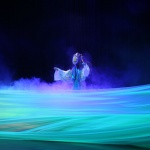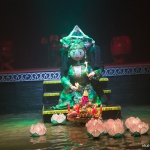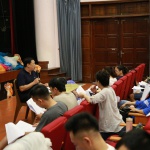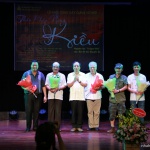The people in this region have been very industrious and creative. In addition to their farm work, they have, based on waterway, created entertainment plays to be performed during festivals, holidays or Traditional Lunar New Year Festival (Tết), and the most typical of these art forms is water puppetry. Water puppetry is a long-standing cultural art form. It has existed for a long time in cultural history of the nation with its uniqueness. It reflects partly farming activities of Vietnamese farmers.
Water puppetry is a unique art form created by the people in the Red River Delta. It was initiated out of the struggle against flooding and irrigation work in service of agricultural production. It has existed in many provinces such as Thai Binh, Phu Tho, Thanh Hoa, Nam Ha, Ha Tay... The uniqueness of water puppetry is the use of water surface as a stage for puppets to play and act. The manipulation room also popularly called puppet room or water pavilion is rigged up over a pond or a lake with balanced architectural style in the shape of a communal house in rural Vietnam. The manipulation room and the stage are decorated with flags, banners, palanquins and gates with votive objects, like a miniature communal house with beautiful dreamy scenery and curved roofs reflecting in water. The water puppet stage is a space in front of the manipulation room. It can only be complete once the show begins and dies out right after the last item of the show ends.

Nghệ thuật Múa Rối phản ánh một phần nào quá trình lao động
của người nông dânViệt Nam
Through the plays and items of traditional water puppetry, daily activities, customs and lifestyle of Vietnamese farmers have been clearly reflected.
To make a puppet, people have to go through different stages such as chiseling the core, making designs and decorating and many other things which cannot be ignored. The more perfect the puppets are the higher the manipulation technique can be raised and the richer the interpretation of the puppets will be. If water puppets are made of good wood, they will be heavy and sink. Fig wood is best for making puppets as it is light and durable, very easy to manipulate in the water.
After the puppets are sculptured with their own styles, the artisans, with creative mind, breathe a new life into them by polishing them with great care and decorating them with different colours to personalize them and make them special and more brilliant to attract the audience. Water puppets are products of popular wood carving. They are rich in real quality but very simple, very fond and lyrical.
In the treasure of traditional water puppets, we can see men ploughing, Tễu, fishermen, orchestra, fairies etc. Here, with a very skillful hand and talent, the artisans bring to us the freshness, honesty, gentleness, optimism and the love for nature of people who are very simple but magnified and artistic. The water puppets, whether made of one piece of wood or several pieces spliced together, have two parts linked together: body and base. The body flows on the water surface to show the character and the base sinks in the water to keep the body float and is installed with machinery, poles and strings to move the puppet.
Manipulation machinery and techniques in water puppet shows are very important, creating movable parts of puppets on the stage. This is the key to the state-of-the art of water puppetry. Beautiful puppets are just of sculpture value. The success of water puppets is mostly based on the motion of their body and actions in a play on the stage. Folk artisans, with their experience and creativeness, have left behind to their next generations many types of water puppet manipulation machinery.
We can find here many tools used daily in wet rice cultivation made by farmers themselves such as ropes, poles, spurts etc. to be part of the manipulating machinery of puppets. There are two main types of puppet manipulating machinery: pole and string which are used to move puppets and create actions for puppet characters. The manipulating machineries are hidden in the water, making use of water power to manipulate puppets from a distance, offering the audience many interesting and surprising moments which are hard to explain. The puppeteers stand in the manipulation room to maneuver the puppets. They manipulate each pole or pull the puppets with a system of strings under water. Standing waist-deep in mud or water to manipulate the puppets is not a normal and interesting job for every one. If having no passion and deep feeling of gratitude for water like wet rice farmers who "soak their skin in water when alive and their bones in water when dead”, it is hard to be inspired to breathe warm sentiments and life to puppet characters.
In water puppetry, the art of using water surface is an important factor creating the power of the puppets. In an outdoor stage in ponds or lakes, as puppetry originates from wordless puppet plays, with only folksongs as an introduction or illustration and background, strong sounds are very important to water puppet shows to keep the pace and rouse the atmosphere. Traditional water puppet guilds often use traditional musical instruments such as large drums, cymbals, and wooden bells. In addition, they also use fireworks and snail horns to effectively support puppet plays. Water puppet music is characterized by festivity uproar, strongly exciting both the puppeteers and the audience.
As an art using actions as a performing language, water puppetry is closely linked to music just like the art of dance. Music controls the speed and keeps pace, guides movements and arouses the atmosphere with a traditional rhythm, playing a decisive role in the stage.
Water puppetry is a long-standing cultural art form of agricultural population in the Red River Delta. Through water puppet plays, viewers feel the nuance of village festivals which here and there reflect their simple dreams for life. They dream for a lucky, happy and peaceful life. Traditional water puppetry has long been imbued with national identity from sweet graceful countryside atmosphere to industriousness, indomitableness and courage of the people in defending their homeland against invaders. It is both secular and close and sacred. It’s a symbol of dreams of the Vietnamese people and is an art very familiar and close to farmers for centuries.
Source: VTV



